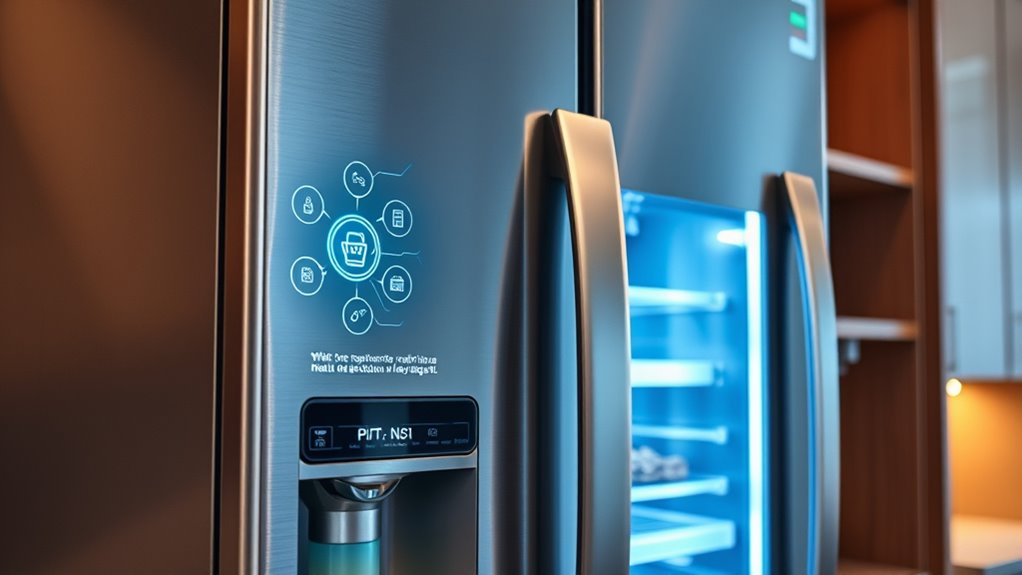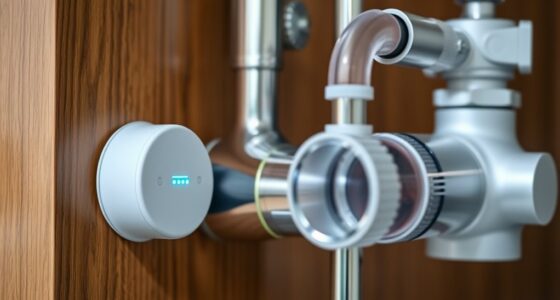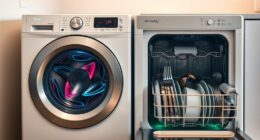Edge AI in appliances allows fault detection to happen directly on the device, enabling real-time monitoring without relying on cloud systems. By using embedded sensors and lightweight machine learning models, you can identify issues early, improve safety, and reduce downtime. This on-device processing supports proactive maintenance and enhances reliability in harsh environments. If you keep exploring, you’ll discover how advancements in sensor integration and future trends are shaping smarter, safer household appliances.
Key Takeaways
- Edge AI enables real-time fault detection within appliances, reducing reliance on cloud systems and supporting immediate maintenance responses.
- On-device AI uses sensors and lightweight models to identify faults early, enhancing safety and prolonging appliance lifespan.
- Combining multi-modal sensor data with machine learning improves diagnostic accuracy and robustness against diverse fault conditions.
- Local processing reduces latency and preserves privacy, ensuring reliable fault monitoring even with limited internet connectivity.
- Future trends focus on smarter appliances with integrated fault prediction, autonomous management, and seamless home ecosystem integration.
The Role of Edge AI in Modern Appliance Fault Detection
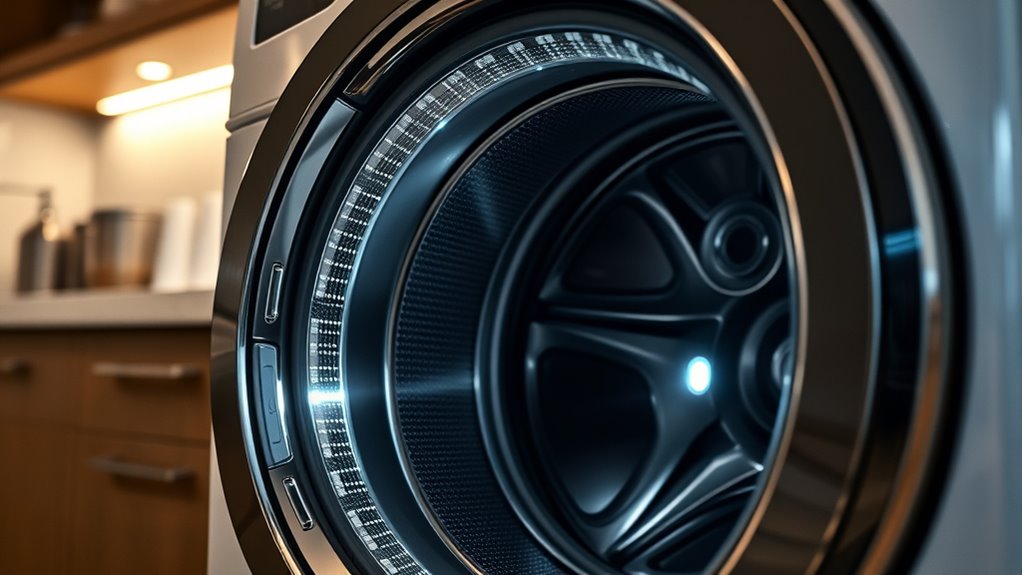
Edge AI plays a crucial role in modern appliance fault detection by enabling real-time, accurate monitoring directly on embedded devices. You can detect motor-bearing issues through vibration, temperature, and acoustic signals without relying on external systems. Traditional methods often need manual interpretation or fixed thresholds, which can miss early or complex faults. With Edge AI, convolutional neural networks (CNNs) run locally on microcontrollers, improving detection precision and reducing false alarms. This setup simplifies system architecture by integrating fault detection into existing control units, lowering hardware complexity. By processing data on-site, Edge AI offers immediate responses, enhancing safety and minimizing downtime. It also adapts to environmental changes, making appliances smarter and more reliable, all while maintaining low power consumption and cost-effectiveness. Advancements in AI hardware are continually making on-device processing more efficient and accessible for consumer appliances.
Advantages of On-Device Processing for Real-Time Monitoring
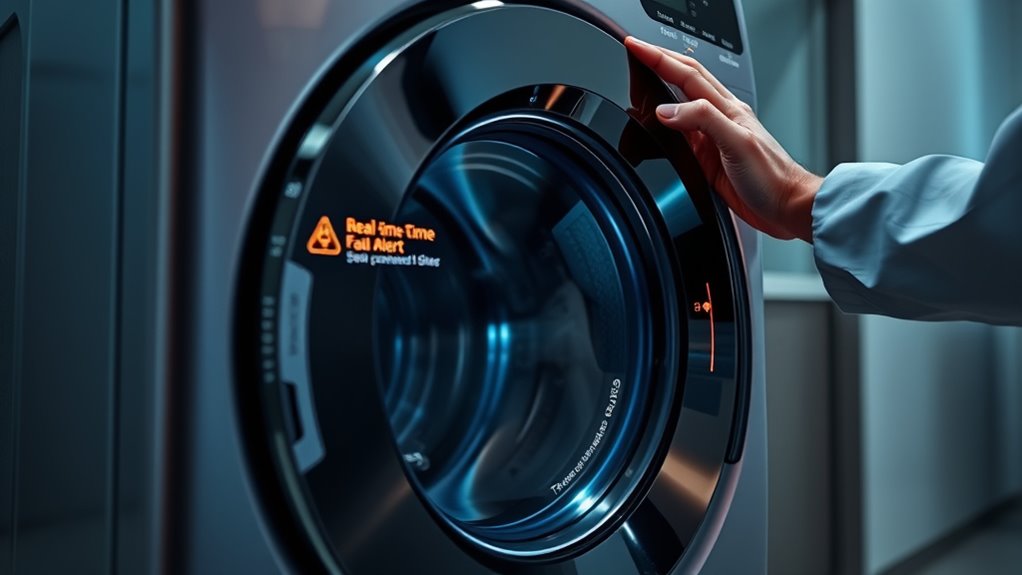
On-device processing allows you to detect faults instantly, reducing delays caused by data transmission and enabling quick responses. It also safeguards sensitive information secure by analyzing data locally, minimizing exposure risks. This approach ensures your appliances operate reliably and privately, even in challenging connectivity conditions. Continuous analysis of telemetry data in real time enhances system responsiveness and fault detection accuracy. Implementing edge AI capabilities in appliances further improves overall reliability and user trust. Additionally, security considerations are critical to prevent unauthorized access and ensure data integrity.
Instantaneous Fault Detection
Real-time fault detection in appliances enables immediate alerts, allowing you to address issues before they escalate. With on-device processing, faults are identified instantly, reducing the time between occurrence and response. This quick detection minimizes unplanned downtime and prevents minor problems from turning into major failures. It also enhances safety by alerting you to potential hazards early, helping you avoid accidents. Continuous monitoring ensures faults are caught right when they happen, improving overall equipment reliability. Since detection happens locally, you don’t need to rely heavily on network connectivity, making the system more dependable. Plus, early fault detection helps save costs by reducing maintenance needs and downtime. Incorporating on-device processing insights can further improve the accuracy of fault detection algorithms, leading to even more reliable monitoring. Overall, instantaneous fault detection empowers you to maintain appliances efficiently, safely, and proactively.
Enhanced Data Privacy
By processing data locally within appliances, you substantially reduce the risk of exposing sensitive information during transmission. Data stays on-device, eliminating interception risks when transferring to remote servers or clouds. This confinement minimizes your attack surface and keeps personal or proprietary data protected within hardware boundaries. Advanced privacy techniques like federated learning enable AI training without sharing raw data, while data anonymization removes identifiable details before storage or sharing. Encryption shields data at rest and during processing, and differential privacy adds noise to mask individual information. Hardware security features, such as Trusted Execution Environments and secure boot, further safeguard your data against internal and external threats. Operating independently from networks, your appliances ensure private, real-time monitoring even in remote environments, supporting compliance with data sovereignty laws and enhancing your control over privacy. Implementing on-device fault detection also minimizes reliance on external systems, reducing potential points of failure and increasing overall system resilience. Additionally, edge AI hardware can be optimized for specific appliance functions, ensuring efficient processing without compromising security.
Key Technologies Powering Appliance Fault Detection Systems
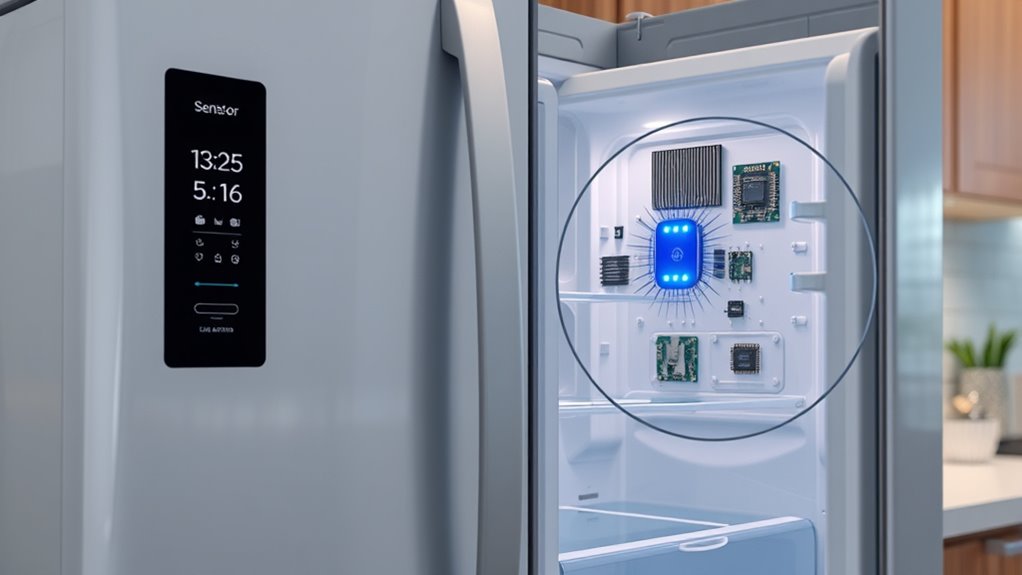
The power behind appliance fault detection systems in edge AI relies on a combination of advanced hardware and sophisticated algorithms. You leverage machine learning models like Random Forest classifiers, which achieve over 97% accuracy in fault detection, outperforming SVM and KNN. Integrated approaches combining RF with Fault Tree Analysis reduce execution time by nearly 28%, optimizing resource use. Embedded hardware such as microcontrollers, CPUs, and FPGAs preprocess sensor data locally, minimizing latency and bandwidth. Multi-modal sensors continuously monitor parameters like vibrations, temperature, and electrical signals, providing real-time data for AI algorithms. Lightweight models running on these platforms enable prompt fault identification. Continuous updates through transfer learning help your system adapt to evolving fault patterns without relying on cloud connectivity, ensuring reliable, instant detection in appliances. Vetted Additionally, careful management of edge computing resources ensures optimal performance and energy efficiency for these systems.
Integrating Multi-Sensor Data for Comprehensive Diagnostics

Integrating data from multiple sensors improves diagnostic accuracy by combining different sources of information. You can use fusion techniques and correlation strategies to identify fault patterns more reliably. This approach helps detect issues early and pinpoints their root causes more effectively.
Sensor Fusion Techniques
Sensor fusion techniques play an essential role in enhancing appliance diagnostics by combining data from multiple sensors to create a more exhaustive view of system health. By integrating heterogeneous signals like vibration, acoustic, and electrical data, you improve fault classification accuracy. Merging time and frequency domain information within fused spectrograms enhances diagnostic capabilities. Transfer learning models on fused data cut down on data needs and boost efficiency. For example, in motor fault detection, fusion helps classify rotor, bearing, and misalignment issues early. Additionally, leveraging multi-sensor data integration techniques ensures more robust and reliable fault detection in complex appliance systems. Incorporating robust data processing methods further increases fault detection accuracy under varying operational conditions.
Data Correlation Strategies
Effective data correlation strategies at the edge hinge on meticulous preprocessing to guarantee sensor inputs are clean, consistent, and meaningful. You should perform data cleaning to eliminate noise, errors, and inconsistencies, boosting fault detection accuracy. Compression algorithms help reduce data volume while preserving critical diagnostic features, enabling efficient processing within resource limits. Data augmentation enhances dataset variability, making models more robust against diverse fault conditions. Real-time validation ensures sensor signals are intact, preventing corrupted data from skewing results. Metadata tagging captures contextual details like timestamps and sensor locations, which are essential for accurate multi-sensor correlation. Additionally, implementing robust data validation techniques helps identify anomalies early, maintaining the integrity of diagnostic processes. Applying sensor calibration techniques can further improve data consistency and reliability across different devices and environments. This foundation enables reliable, all-encompassing diagnostics directly on the device.
Fault Pattern Recognition
Fault pattern recognition in appliances relies on combining data from multiple sensors such as vibration, temperature, and electrical current to identify issues accurately. By fusing these inputs, you gain a holistic view of the appliance’s health, enabling precise fault detection. Vibration sensors reveal mechanical imbalances, while temperature sensors highlight overheating risks. Electrical current sensors detect abnormal loads or shorts, pinpointing electrical faults. This real-time data integration on-device allows immediate anomaly detection without relying on the cloud. Here’s a comparison of key sensors:
| Sensor Type | Faults Detected | Key Benefits |
|---|---|---|
| Vibration | Mechanical issues, wear | Mechanical diagnostics |
| Temperature | Overheating, thermal stress | Prevent thermal failures |
| Electrical Current | Short circuits, abnormal loads | Electrical fault pinpointing |
This synergy enhances fault detection accuracy and responsiveness. Additionally, integrating sensor data effectively can improve predictive maintenance strategies and extend appliance lifespan.
Enhancing Appliance Safety and Reliability Through AI

Implementing Edge AI directly within household and industrial appliances substantially boosts safety and reliability by enabling real-time fault detection and predictive maintenance. This on-device intelligence allows you to identify issues instantly, reducing hazards like electrical faults or overheating. Plus, it works reliably in harsh environments with extreme temperatures, vibration, and dust, thanks to robust sensor integration. With local processing, you don’t need constant internet access, ensuring consistent monitoring even in remote locations. Continuous local data analysis helps you detect early signs of wear, enabling timely maintenance and extending appliance lifespan. Robust sensor integration ensures that data collection remains accurate and dependable under challenging conditions. Additionally, advancements in appliance tuning techniques can further optimize performance and durability, contributing to overall safety.
Technical Architecture of Edge AI Fault Detection Modules

The core of Edge AI fault detection modules lies in a carefully designed architecture that integrates advanced algorithms with specialized hardware. You combine Random Forest classifiers with Fault Tree Analysis to accurately detect and identify fault sources directly on the device, reducing latency by approximately 28%. Microcontroller units (MCUs) with embedded Neural Processing Units (NPUs) offload AI tasks from the main CPU, boosting speed and responsiveness. These MCUs feature 64-bit cores and ample flash memory, enabling real-time processing, fault detection, and other control functions without relying on the cloud. Fully integrated AI toolchains streamline development and deployment of optimized models. Localized signal processing allows your system to analyze vibration, temperature, and electrical data instantly, issuing immediate alerts and automated responses while minimizing data transmission and power consumption. Additionally, robust AI in appliances ensures the system adapts to evolving fault patterns and improves accuracy over time. Incorporating edge computing capabilities further enhances real-time decision-making and reduces dependency on external networks.
Benefits of Predictive Maintenance in Household Appliances
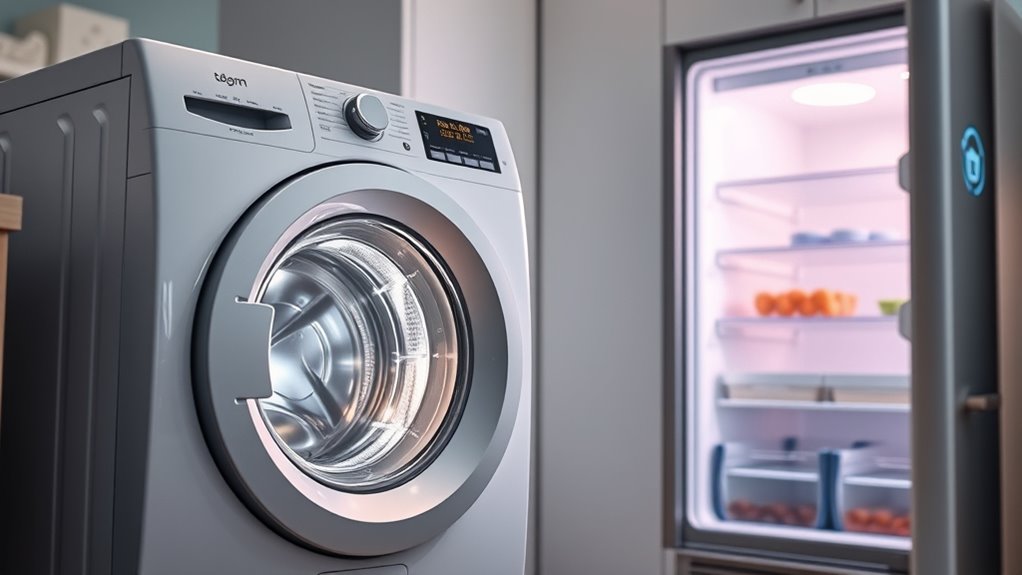
Edge AI fault detection modules enable household appliances to identify issues early, paving the way for smarter maintenance strategies. Predictive maintenance offers several benefits:
- Cost savings — it can cut maintenance expenses by up to 25% by preventing emergency repairs and unnecessary checks.
- Increased uptime — appliances stay operational 10-20% longer, reducing unexpected breakdowns.
- Enhanced efficiency — models boost productivity by 25%, minimizing failures and optimizing repair timing.
- Safety improvements — early fault detection reduces hazards like electrical fires and mechanical failures.
- Proactive maintenance — aligning with the Law of Attraction principles, it fosters a mindset focused on positive outcomes and continuous improvement.
Overcoming Challenges in Implementing Edge AI Solutions
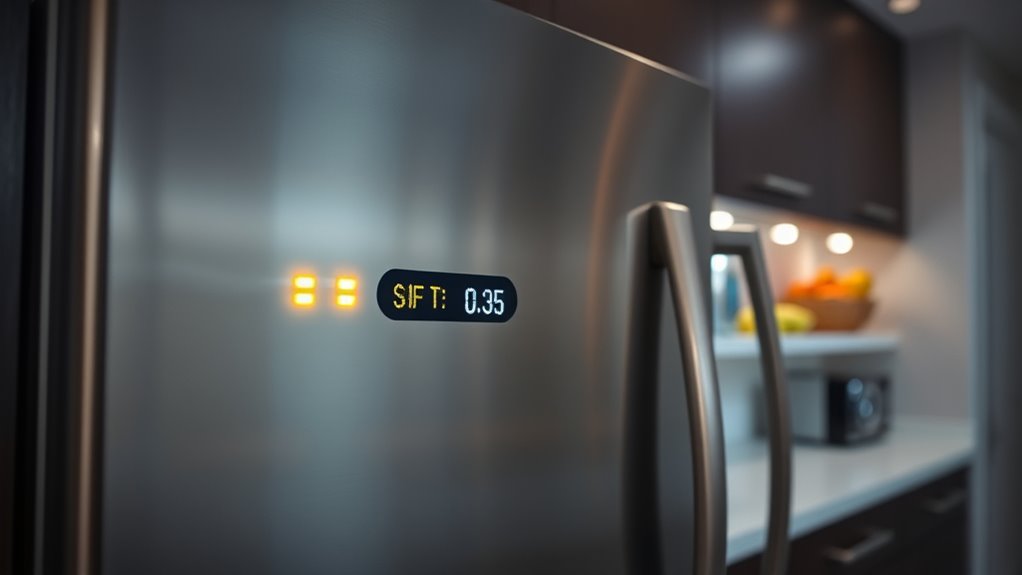
While Edge AI offers significant benefits for household appliances, deploying these solutions faces several hurdles. High initial costs and investments can be a major barrier, as advanced hardware, software development, and integration require substantial funds. Upgrading devices to support Edge AI involves powerful processors and energy-efficient components, adding to expenses. Data integration and interoperability pose challenges too — ensuring seamless communication across different brands and standards isn’t easy. Limited processing power and memory constraints restrict AI capabilities on edge devices, demanding optimized models and energy-efficient algorithms. Privacy and security concerns also need attention; protecting data with encryption and regular updates is essential. Additionally, a shortage of specialized expertise hampers development, making it harder to implement effective solutions quickly and confidently. Moreover, the use of Edge AI hardware such as efficient processors and sensors can significantly impact deployment success. Additionally, understanding Home Essentials can help consumers make informed decisions about appliance features and compatibility.
Future Trends and Developments in Appliance Fault Detection

As smart connectivity becomes increasingly integrated into household appliances, you can expect real-time self-diagnosis and fault reporting to become standard features. This shift will enhance maintenance efficiency and user experience. Here are some future developments to watch for:
- Embedded sensors and communication modules will enable appliances to automatically detect and report faults, reducing the need for manual inspections.
- Integration with home ecosystems like Alexa or Google Home will allow remote control and instant fault notifications.
- AI algorithms will analyze operational data to identify subtle deviations and predict failures before they occur.
- Multi-sensor fusion and miniaturized detection devices will improve fault characterization accuracy while maintaining appliance aesthetics.
- Incorporating Home Improvement principles, such as organized monitoring systems, can facilitate more effective fault detection and maintenance routines.
These trends will make appliances smarter, safer, and more reliable.
Frequently Asked Questions
How Secure Is On-Device AI Data Processing in Appliances?
On-device AI data processing in appliances is quite secure, as it keeps your sensitive information within the device, reducing exposure to external threats. You benefit from hardware protections like TPM chips and trusted firmware, which verify system integrity. However, you should guarantee robust security measures are in place, such as strong authentication and regular updates, because new attack vectors and local data risks can still pose challenges if not properly managed.
Can Edge AI Adapt to Changing Appliance Usage Patterns Over Time?
Yes, edge AI can adapt to changing appliance usage patterns over time. You’ll benefit from on-device learning techniques like incremental, transfer, and federated learning, which allow the AI to update itself with new data without relying on cloud connection. This continuous adaptation helps your appliances respond more accurately to new behaviors, optimize performance, and detect faults early, all while maintaining privacy and reducing latency for real-time decisions.
What Is the Energy Consumption Impact of Integrated AI Systems in Appliances?
Think of integrated AI systems in appliances as the engine in a car—when efficient, they power smoothly without draining fuel. Your AI-enabled appliance’s energy impact is relatively low, thanks to local processing that reduces network and cloud reliance. Using optimized models and hardware accelerators, you can cut power consumption profoundly. This setup helps you save energy while maintaining smart functionality, making your appliances both eco-friendly and effective.
How Scalable Are Edge AI Fault Detection Solutions for Different Appliance Sizes?
You’ll find that edge AI fault detection solutions are highly scalable across various appliance sizes. By leveraging versatile hardware and distributed processing, you can adapt these systems to small devices or large industrial equipment. Techniques like model optimization and orchestration frameworks guarantee smooth deployment. This flexibility allows you to expand fault detection capabilities efficiently, reduce costs, and improve performance regardless of the appliance’s size or complexity.
What Are the Maintenance Requirements for Ai-Enabled Fault Detection Modules?
You need to regularly calibrate sensors, guarantee protective enclosures are intact, and monitor sensor health remotely via dashboards. Keep the power supply stable, considering backups if needed. Continuously update and validate AI models with new data, using over-the-air updates. Maintain secure, local data processing, and schedule maintenance based on AI insights rather than fixed schedules. Empower your team with centralized management tools and real-time alerts to keep fault detection modules functioning at their best.
Conclusion
So, next time your fridge politely warns you about a potential meltdown or your washing machine secretly becomes a detective, thank Edge AI. It’s like having a tiny Sherlock Holmes inside your appliances, catching faults before they turn into disasters. Who knew that your smart toaster or dishwasher could be so nosy? With these tech marvels, you’re not just living in the future—you’re laughing at the past’s clunky, clueless appliances. Cheers to smarter, sassier homes!
